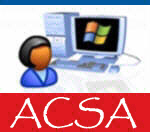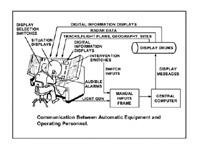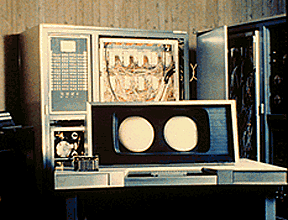|
|||||||||||||
The central computer is a binary, parallel machine with an 8192-word magnetic core memory and a speed of roughly 75,000 single-address instructions per second (75Kips). Based on the earlier Whirlwind I computer, this model later became known as the Whirlwind II. Numbers representing positional data are stored and processed as vectors with two 16-bit components in order to facilitate processing. One of many thousands of FSQ-7 Components FOR A DETAILED VIEW OF SAGE and the FSQ07 and FSQ08 CLICK HERE The FSQ-7 is the spiritual grandfather of all "OS-based" (operating system based) mainframe computer systems and the father of the machines that became IBM's primary mainframe offerings from 1960 to the present day. Many of the advancements introduced in the subsequent 7090 stretch, 360 and 370 architecture mainframes were actually not developed by IBM nor RCA, but by the University of Manchester and Ferranti LTD of England, in the ATLAS Computer, brought to the attention of IBM by British Petroleum for whom an ATLAS was built. Adaptation and Integration of concepts developed in military research and academia drove IBM's development of large scale computers up through it's adoption of standard desktop computers developed internally by engineers at Citibank for it's "standardized office desktop computer" used in Federal Funds Trading and Assets and Liabilities activities at the giant Bank in the mid 1970s. This deviation into products developed by commercial research, lead to the advent of the Personal Computer and the RS series computers and the hiring of Microsoft to market operating and "office of the future" software for the PCs and MACs. Citibank's corporate genealogy is related to General Electric. Developed as a successor to the MIT Whirlwind I Computer, the FSQ-7 is the architectural forerunner, allegedly, of the RCA Spectra 70 and the IBM "stretch" 709/7090, duplicated by Xerox in joint efforts with MIT the Sigma 7 and the Sperry Univac 1170 series. Further evolved and extended models became the IBM 360 and 370 series computers which are still being manufactured in current, highly advanced editions today by IBM Corporation. IBM, which like RCA, is related to General Electric Corporation, became the dominant Mainframe Computer Company in the world in 1963. IBM eventually pushed Xerox, Burroughs and Sperry Rand / Univac (founder of the field) out of the Mainframe Computer Marketplace. Interestingly, AT&T, was also created by GE (IBM was created by John C. Flint, a JP Morgan trust builder, with money from then largest owners of Standard Oil and General Electric, the Rockefeller family, whose accumulation of assets and wealth since 1863 is inestimable and can no longer be tracked in the traditional sense. Originally based on the Tab Card business of Hollerith Company, a German-owned American business, IBM was gradually built up to supply typewriters, weapons, tab card systems, and later, computers for Rockefeller/Morgan owned businesses, while fueled by it's massive Government contracts around the world to use its equipment to perform the national census takings. IBM has perennially played the "in between", selling to one and all, irrespective of states of political or military antimony, sometimes accused by some of fostering war for the sake of profit.) This "push" to dominate the computer industry later resulted in IBM's landmark indictment for Anti-Trust Violations, which it settled with the US Department of Justice in 1965 agreeing to provide it's operating system source code to any competitor who made a compatible computer to its own, for no charge, and not to bundle DP Services with its bread-and-butter Mainframe line. Part of the problem with the indictment was the "incestuous" relationships that were prolific in the computer industry, with Xerox and Univac related to AT&T, IBM and RCA related to GE and all of them related to Standard Oil and the business families Rockefeller and Morgan. It was the conflict over who controlled critical operating code that was critical to the United States: Sage (which stood for The Semi-Automatic Ground Environment) linked hundreds of radar stations in the United States and Canada. The Sage fostered the first large-scale computer communications network that eventually became DARPA Net.
Input to the SAGE computers was entered by touching a light gun to the screen. SAGE's central computer was the AN/FSQ-7, known as Whirlwind II, and developed at MIT, built by IBM. Each computer had 55,000 vacuum tubes, 175 diodes, and 13,000 transistors, and required 1 megawatt of power. The system weighed 113 tons. SAGE accelerated the transfer of these technologies throughout the nascent computer industry. While (MIT) Lincoln Laboratory was given primary responsibility for SAGE, the project also involved several private firms such as IBM, RAND, Systems Development Corporation (the spin-off from RAND), Burroughs, Western Electric, RCA, and AT&T.2 Through this complex relationship between academia, industry, and the military, SAGE technologies worked their way into commercial products and helped establish the industry leaders. SAGE was a driving force behind the formation of the American computer and electronics industry (Freeman, 1995, p. 33). IBM built 56 computers for SAGE, earning over $500 million, which helped contribute to its becoming the world's largest computer manufacturer (Edwards, 1996, pp. 101-102; Freeman, 1995, p. 33). At its peak, between 7,000 and 8,000 IBM employees worked on the project. SAGE technology contributed substantially to the SABRE airline reservation system marketed by IBM in 1964, which later became the backbone of the airline industry (Edwards, 1996, p. 102). Kenneth Olsen, who worked on Whirlwind before founding Digital Equipment Corporation, called Whirlwind the first minicomputer and states that his company was based entirely on Whirlwind technology (Old Associates, 1981, p. 23). IBM continued to develop the 7 series computers into the 7030 and 7090 later redubbing the product line System 360, System 3 and System 370.
The enormous value of these computers led to market competition that was cut-throat, IBM with backing by GE and partnership with RCA, fought off it's competitors and their AT&T progeny until they faded into Mainframe computing obscurity. The Anti-Trust suit eventually led to IBM choosing to distribute PC DOS and PC Windows through Microsoft Corporation, so that no further Anti-Trust charges could be filed against it, as despite the spiritual win, IBM found the Anti-Trust lawsuit by the Department of Justice extremely expensive, as did General Electric and other owners of IBM, such as GE's owners, the Rockefeller Family and the JP Morgan Capital Trust. Today, IBM's Mainframes run literally 98% of all large scale mainframe based back office operations throughout the world, but is gradually losing market share to distributed server technologies running Windows 2003 Server, Sun Solaris and AT&T Unix and it's derivatives such as Linux, Linspire and Novell Netware.
copyright 2005 acsa.net |
|||||||||||||




